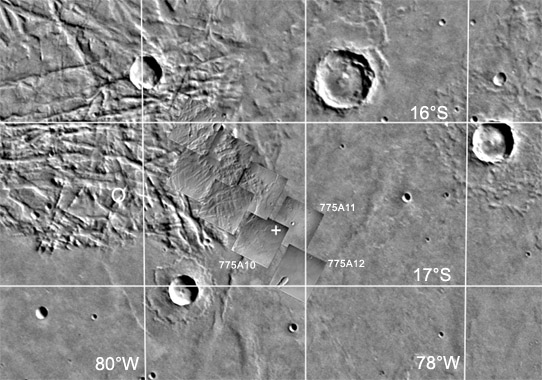
 |
Eight successive images from the Viking mission are shown in the foreground. The object is located in
northern Solis Planum and can be found on two Viking Orbiter images of 1978-08-01,
775A10 and 775A11, separated by 4.5 seconds (ENA 16°, INA 65°, LST
15.37, 12.7 m/pix). The object is at the white cross at 16.7° S 79.2°
W. |
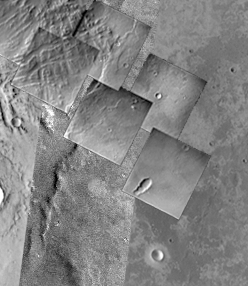 |
It is visible now below a crater
as a bright dot. The site was neither imaged by MOC nor Themis visual but
a Themis thermal image covered it. The left image strip is Themis visual I06681044 (100
m/pix), the right one is Themis visual I06656022, the middle one is from the map above and the blinked in image is Themis thermal I06226010 (LST 5.44,
INA 97°). The area shows an active past: Chaotic terrain in the upper left and an elliptical volcano pit lower left of center. Most craters and the pit are thermal dark, perhaps cooled by evaporated water during the night. A notable exception is the lower right crater with its hot interior. It is almost certainly an impact crater but perhaps connected to a vulcanic water vent. The site of the object shows no thermal activity. |
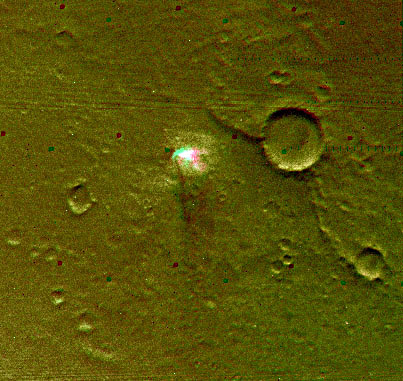 |
Here the two VO images are
adjusted and matched together in a red/green stereo anaglyph of the
object and its immediate surroundings. The large crater with the ramp
(probably an evaporite) has a diameter of about 800 m. The base of the
plume is like a dark conical column of 100 m diameter and about 1000 m
high (ENA 16°) and the bright cloud even higher. The shadow of the
object seems two-parted. One flat on the ground and one leaving the
ground. That would mean it is no shadow but a dark upward column of water
or dust. |
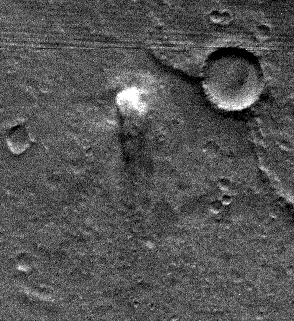 |
Here the two images are matched
to a fast blink. The topographic background of the object is well fixed
but the object moves from the left to the right. It is notable that the
whole object with all of its shadow moves. The movement of the shadow
could not be related to a stereo effect, the topography is too flat.
The movement of the whole object strongly points to a dust devil. In a
water eruption only the upper plume could drift by wind, never the lower
part because surface winds are too slow and the ejection momentum at
the speed of an expected vent much too high. The conclusion of a dust devil is further supported by the partial transparency of the object. That is typical for dust devils but not for water eruptions. Water droplets are of much larger size than dust and therefore always opaque like terrestrial clouds. |
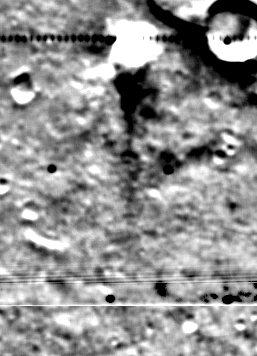 |
What in 1980 was thought to be a
shadow is actually the column of the tornado-like dust devil. The column
with about the same shape is visible in both images. But in the second,
a dark veil on the right gives the impression of a widening shadow. This
veil could be some dust in the upper part of the dust devil far above
ground in the line of sight. Just by chance it corresponds to the
visible geometry of the column to support the impression of a shadow. Albedo changes probably due to shadow movement are visible to about 1.9 km (150 pix) from the column base. At INA 65° that corresponds to a column height of about 4 km, not unusual for a Martian dust devil. MSSS reported one of 8 km height in a MOC wide angle image in 1999. Most shadows on MOC narrow angle images leave the frame. The end of this shadow is perhaps not visible in the double-image. Without movement in the single image part of 775A11 it is not discernible from surface colorations. Note the transmission error artifacts and the black dot reference marks in this blink. It is not cleaned (like the ones above) to allow better analysis. |